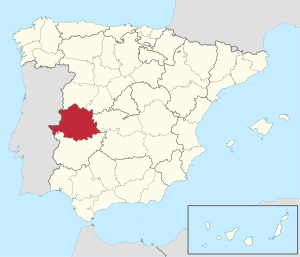Province of Cáceres
|
Cáceres Extremadura , Spain |
|
|---|---|
 coat of arms |
 flag |
| Basic data | |
| Autonomous Community : | Extremadura |
| Capital : | Cáceres (Spain) |
| Official language : | Spanish |
| Area : | 19,868 km² |
| Residents : | 394.151 (Jan. 1, 2019) |
| Population density : | 19.84 inhabitants / km² |
| ISO 3166-2 : | ES-CC |
| Website : | dip-caceres.es |
| Location of the province of Cáceres | |
The province of Cáceres is located in western Spain in the autonomous community of Extremadura . The sparsely populated province (approx. 20 inhabitants per km²) is the second largest in Spain with 19,868.22 km².
Geographical location
The province of Cáceres occupies the northern part of Extremadura. It borders the province of Salamanca in the north, the province of Avila in the northeast, the province of Toledo in the east, the province of Badajoz in the south and Portugal in the west .
Cities
The provincial capital is the city of Cáceres , the second largest city is Plasencia . 394,151 people live in the province of Cáceres (2019), around a quarter of them in the capital.
- Biggest places
As of January 1, 2019
| local community | Residents |
|---|---|
| Cáceres | 96.126 |
| Plasencia | 39,913 |
| Navalmoral de la Mata | 17.129 |
| Coria | 12,478 |
| Miajadas | 9,607 |
| Talayuela | 7,371 |
| Trujillo | 9.012 |
| Moraleja | 6,750 |
| Jaraíz de la Vera | 6,478 |
| Arroyo de la Luz | 5,811 |
| Valencia de Alcantara | 5,397 |
| Montehermoso | 5,739 |
Attractions
- The old town of Cáceres (UNESCO World Heritage since 1986).
- The Real Monasterio de Nuestra Señora de Guadalupe ( UNESCO World Heritage since 1993).
- The Puente de Alcántara , a Roman bridge from 106 AD that is still passable.
- The Monfragüe National Park .
- The Reserva Natural Garganta de los Infiernos nature reserve .
- The Guayasamín House Museum in Cáceres, so far the only museum in Europe dedicated to the work of the Ecuadorian painter Oswaldo Guayasamín .
- The Aljibe cistern of Cáceres , carved into the rock at the highest point of the old town of Cáceres , the largest cistern construction in the world (UNESCO World Heritage since 1986).
- The Almaraz nuclear power plant near Cáceres.
- The Santa Ana Cave , located on military grounds, is part of a system of karst caves in the region.
- The Via de la Plata is a Roman road that runs north to south of the Cáceres region. There are many remains from Roman times such as Castra Cecilia, Castra Servilia or El Junquillo. It also leads past Valdesalor, near which there is a reconstructed Roman bridge called the Puente de la Mocha.
- The Dolmen del Mellizo near the village of Aceña de la Borrega and the Dolmen of Alcántara .
- The Museo Vostell Malpartida , founded by the German Fluxus artist Wolf Vostell in the Los Barruecos nature reserve near Malpartida de Cáceres .
Population development of the province

Web links
Commons : Province of Cáceres - Collection of images, videos and audio files
Individual evidence
- ↑ Cifras oficiales de población resultantes de la revisión del Padrón municipal a 1 de enero . Population statistics from the Instituto Nacional de Estadística (population update).
- ^ Diócesis Coria - Cáceres . Website of the Diocese of Cáceres. Retrieved September 12, 2014.
- ↑ Via de la Plata.Retrieved August 29, 2014.

